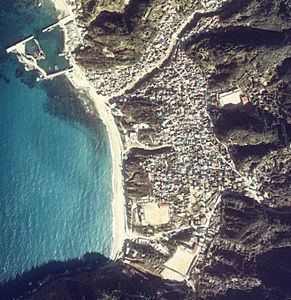Location Izu Islands Length 6,000 m (20,000 ft) Coastline 22,000 m (72,000 ft) Elevation 572 m Island group Izu Islands | Archipelago Izu Islands Width 400 m (1,300 ft) Highest elevation 571 m (1,873 ft) Area 18.87 km² | |
 | ||
Kōzu-shima (神津島) is a volcanic Japanese island in the Philippine Sea. The island is administered by Tōkyō and located approximately 30 kilometres (19 mi) northwest of the Miyake-jima and 14 kilometres (8.7 mi) southwest of the Nii-jima. It is one of the Izu Seven Islands group of the seven northern islands of the Izu archipelago. Kōzushima is administratively part of Kōzushima Village under Ōshima Subprefecture of Tokyo Metropolis. As of 2009, the island's population was 8,363. Kōzushima is also within the boundaries of the Fuji-Hakone-Izu National Park.
Contents
Map of K%C5%8Dzu-shima, Kozushima, Tokyo, Japan
Geology
Kōzu-shima is a compound volcanic island 6 km in length with a maximum width of 4 km. The island is formed from a cluster of eighteen lava domes, with rhyolite and pyroclastic ash deposits. The highest of these lava domes, Tenjō-san (天上山), has a height of 571 metres (1,873 ft), and was last active in 838 AD per the ancient Japanese history Shoku Nihon Kōki. Compared with most of the other islands in the Izu archipelago, Kōzu-shima is relatively flat, with small eroded hills, and lacks the high coastal cliffs found on the other islands. Earthquake swarms have occurred at Kōzu-shima during the 20th century.
History
Kōzu-shima has been inhabited since at least the Japanese Paleolithic era, and archaeologists have found Jomon period stone tools made from obsidian in Shizuoka and Yamanashi Prefectures. Under the Ritsuryō system of the early Nara period, the island was part of Suruga Province. It was transferred to Izu Province when Izu separated from Suruga in 680 AD. During the Heian period, obsidian was the primary export from the island.
